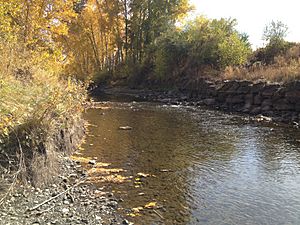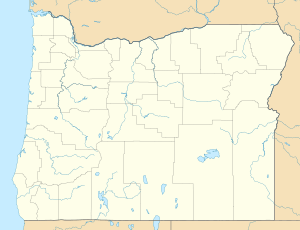Powder River (Oregon) facts for kids
Quick facts for kids Powder River (Oregon) |
|
|---|---|

The Powder River at Baker City
|
|
|
Location of the mouth of the Powder River in Oregon
|
|
| Native name | Polalle Illahe |
| Other name(s) | Port-pel-lah |
| Country | United States |
| State | Oregon |
| Region | Baker and Union counties |
| Physical characteristics | |
| Main source | Confluence of McCully Fork and Cracker Creek Sumpter, Oregon in the Sumpter Valley Dredge State Heritage Area, Blue Mountains 4,400 ft (1,300 m) 44°44′30″N 118°12′22″W / 44.74167°N 118.20611°W |
| River mouth | Brownlee Reservoir on the Snake River 10 mi (16 km) east of Richland, Oregon 2,064 ft (629 m) 44°44′37″N 117°02′56″W / 44.74361°N 117.04889°W |
| Length | 153 mi (246 km) |
| Basin features | |
| Basin size | 1,603 sq mi (4,150 km2) |
| Type: | Scenic |
| Designated: | October 28, 1988 |
The Powder River is a river in northeast Oregon, USA. It flows for about 153 miles (246 km) and eventually joins the Snake River. The river helps drain a large area on the eastern side of the Blue Mountains. Most of the Powder River is in Baker County. However, a part of it forms the border between Baker County and Union County.
Contents
What's in a Name?
The name Powder River was first written down by Peter Skene Ogden. It is believed that explorer Donald Mackenzie gave the river its name. William C. McKay, whose grandfather was a partner of John Jacob Astor, said the name comes from the sandy soil along the riverbanks. This sandy soil was called polalle illahe in Chinook Jargon. On maps made by the Lewis and Clark Expedition, the river was called Port-pel-lah.
River's Journey
The Powder River starts in the southern Blue Mountains. Its main stream begins in Sumpter. Here, smaller streams like McCully Fork and Cracker Creek join together. The river then flows through areas where gold mining used to happen. It then enters Phillips Reservoir.
After leaving Phillips Reservoir, the river flows east. It then turns sharply north through the Bowen Valley and Baker City. From there, the river winds through the Baker Valley. It passes by the towns of Haines and North Powder. At North Powder, the North Powder River joins it.
The river then turns east-southeast again. It flows through Thief Valley Reservoir. This part of the river runs along the southern edge of the Wallowa Mountains. Finally, the Powder River enters the Snake River at the border between Oregon and Idaho. This is near the Brownlee Dam.
Smaller Streams Joining the River
Some of the main streams that flow into the Powder River are Eagle Creek, Wolf Creek, Rock Creek, and the North Powder River.
The Powder River Area
The land area that the Powder River drains is called its watershed. This watershed covers about 1,603 square miles (4,152 square kilometers) in northeast Oregon. There are three man-made lakes, called reservoirs, on the Powder River:
- Phillips Reservoir (behind Mason Dam)
- Thief Valley Reservoir
- The Powder arm of Brownlee Reservoir, where the Powder River meets the Snake River.
In 1988, about 11.7 miles (18.8 km) of the Powder River was named a Wild and Scenic River. This means it's protected for its natural beauty. This special part of the river flows through a rugged canyon with amazing rock formations.
Animals and Plants of the River
Beavers and Their Homes
Beaver populations are growing along the Powder River. You can often see them near Oregon Route 7 below Mason Dam, about 14 miles (23 km) from Baker City. A group of beavers built a large dam there. You can easily see it from a footbridge near the parking area.
Beavers were once almost gone from this area. But now they are making a comeback. In dry eastern Oregon, beavers are very helpful. Their dams create ponds where young salmon can grow. These ponds also help fill up underground water supplies. Beaver ponds also create wetlands that trap dirt and pollution, making the water cleaner.
Fish in the River
The Powder River used to be a very important place for Chinook salmon and steelhead trout to lay their eggs. These fish would swim all the way from the Pacific Ocean. Thousands of Chinook salmon once came to the Powder River and its smaller streams to spawn.
However, this stopped when the Thief Valley Dam was built in 1931. Later, two more dams were built on the Snake River in Hells Canyon. These dams also blocked the fish from swimming up the river. Today, the Oregon Department of Fish and Wildlife sometimes releases Chinook salmon into the Powder River for people to fish.



